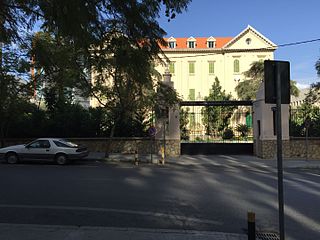 W
WAchrafieh is one of the oldest districts of Beirut, Lebanon.
 W
WBadaro is a well-known residential neighbourhood and business hub in the heart of Beirut. The neighborhood is roughly bounded by the Pierre Gemayel avenue on the north, the Hippodrome on the west, Sami el Solh avenue on the east, Beirut's pine forest on the south east and the Tayyouneh roundabout on the south. Badaro is the common name of Beirut's "Horsh" (park) administrative district which also includes three parks: a 75 acres (30 ha) pine forest known as Horsh Beirut, the Beirut Hippodrome and the Pine Residence, the French ambassador's residence.
 W
WThe Beirut Central District (BCD) or Centre Ville is the historical and geographical core of Beirut, the capital of Lebanon. Also called downtown Beirut, it has been described the “vibrant financial, commercial, and administrative hub of the country.” It is thousands of years old, traditionally a focus of business, finance, culture and leisure.
 W
WBourj el-Barajneh is a municipality located in the southern suburbs of Beirut, in Lebanon. The municipality lies between Beirut–Rafic Hariri International Airport and the town of Haret Hreik.
 W
WBourj Hammoud, is a town and municipality in Lebanon located north-east of the capital Beirut, in the Metn district and is part of Greater Beirut. The town is heavily populated by Armenians. Bourj Hammoud is a mixed residential, industrial and commercial area and is one of the most densely populated districts in the Middle East. Bourj Hammoud has a major waterfront at Beirut's north gateway that underwent, however, an anarchic urban development.
 W
WDahieh is a predominantly Shia Muslim suburb composed of several towns and municipalities south of Beirut, located in the Baabda District of Lebanon. There is also a minority of coexisting Sunni Muslims, and a Palestinian refugee camp which has 20,000 inhabitants. It is located north of the Rafic Hariri International Airport, with the M51 Freeway that links Beirut to the Airport passing through it. Prior to the 2006 Israel-Lebanon conflict, Dahieh was a residential and commercial area with malls, stores and souks.
 W
WHadeth Beirut or Hadeth south is a Heavy Neolithic archaeological site approximately 7 kilometres (4.3 mi) south southeast of Beirut, on the road to Sidon in Lebanon. It was discovered and a collection made by Auguste Bergy from a spur near a ravine south of the last houses in the village. Heavy Neolithic material of the Qaraoun culture was found of an atypical variety with large, rough flakes including picks, choppers and cores. Some examples showed evidence of burin impacts and twisted forms. The area is now built up.
 W
WHamra is a neighborhood in Beirut, Lebanon. The center of the neighborhood, Hamra Street, is one of Beirut's major commercial districts, and is known for its fashion stores, as well as many restaurants, cafes, bars and hotels. The area is known for having a lively nightlife.
 W
WHaret Hreik is a mixed Shia and Maronite Christian municipality, in the Dahieh suburbs, south of Beirut, Lebanon. It is part of the Baabda District. Once an agricultural village, Haret Hreik lost its rural identity due to the wave of refugees from Southern Lebanon who settled in the town and made it another urban neighborhood of Dahieh.
 W
WWadi Abu Jamil is the former Jewish quarter in Beirut, Lebanon, located in the city's central district.
 W
WMar Mikhaël is a residential and commercial neighborhood in the Medawar district of Beirut, Lebanon. It is a fashionable area with cafes, restaurants, art galleries, bakeries and shops. The neighborhood is named after the Maronite Catholic Church of St. Michael, which is located on Rue Pharoun.
 W
WRaouché is a residential and commercial neighborhood in Beirut, Lebanon. It is known for its upscale apartment buildings, numerous restaurants, and cliff-side cafés that line Avenue de Paris, which forms part of the Corniche Beirut. The corniche or the wide, seaside sidewalk of Avenue de Paris is popular on weekends and evenings where strollers and joggers crowd the pavements.
 W
WRas Beirut is an upscale residential neighbourhood of Beirut. It has a mixed population of Christians, Muslims, Druze, and secular individuals. Ras Beirut is home to some of Beirut's historically prominent families, such as the Rebeiz family, the Daouk family, the Itani family, the Sinno family,the Sidani family, the Beyhum family and others. Included in the area are a number of international schools and universities, including the American University of Beirut (AUB) and International College Beirut (IC).
 W
WRmeil is one of the districts of Beirut, the capital of Lebanon. It is located near Ashrafieh, Medawar and Saifi. Two Greek Orthodox churches are situated there, and the Sursock Museum. Saint George Hospital University Medical Center is also located in Rmeil.
 W
WSaifi Village is a residential upscale neighbourhood in Beirut, Lebanon. Saifi Village is located at the southeastern periphery of Centre Ville. The village is bordered by Rue Charles Debbas to the south, Rue George Haddad to the east, Rue Gouraud to the north, and Rue Ariss & Kanaani to the west. Its location is at the beginning of the former Green Line, the main frontline in Beirut during the Lebanese Civil War.
 W
WSassine Square is a town square in Beirut, Lebanon, it is one of the most prominent urban areas of East Beirut, Lebanon. It is located in the Achrafieh district.
 W
WZuqaq al-Blat is one of the twelve quarters of Beirut.